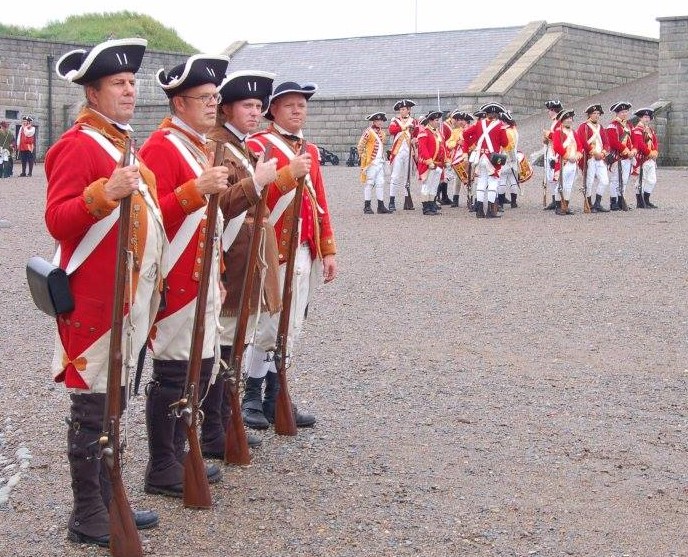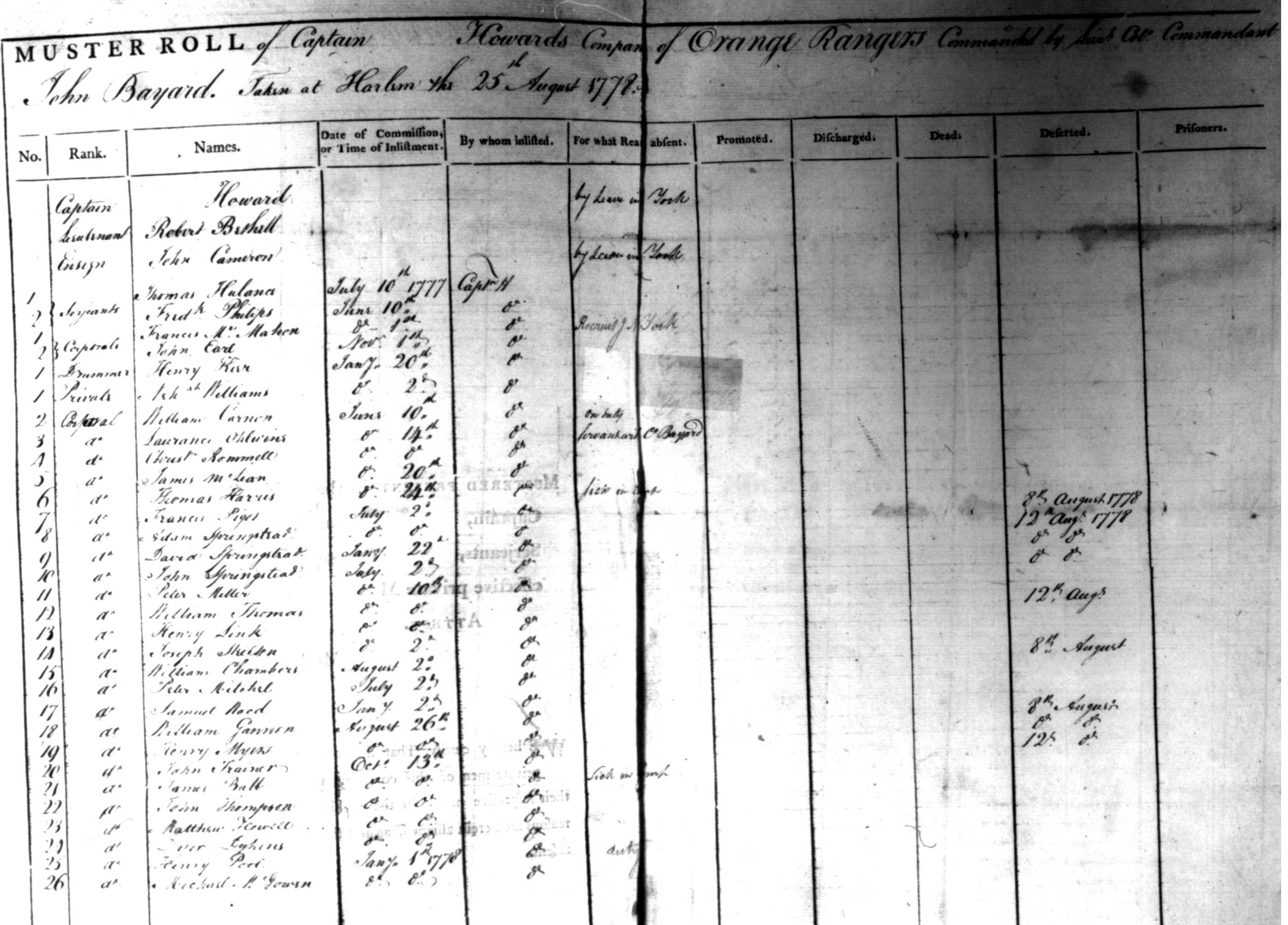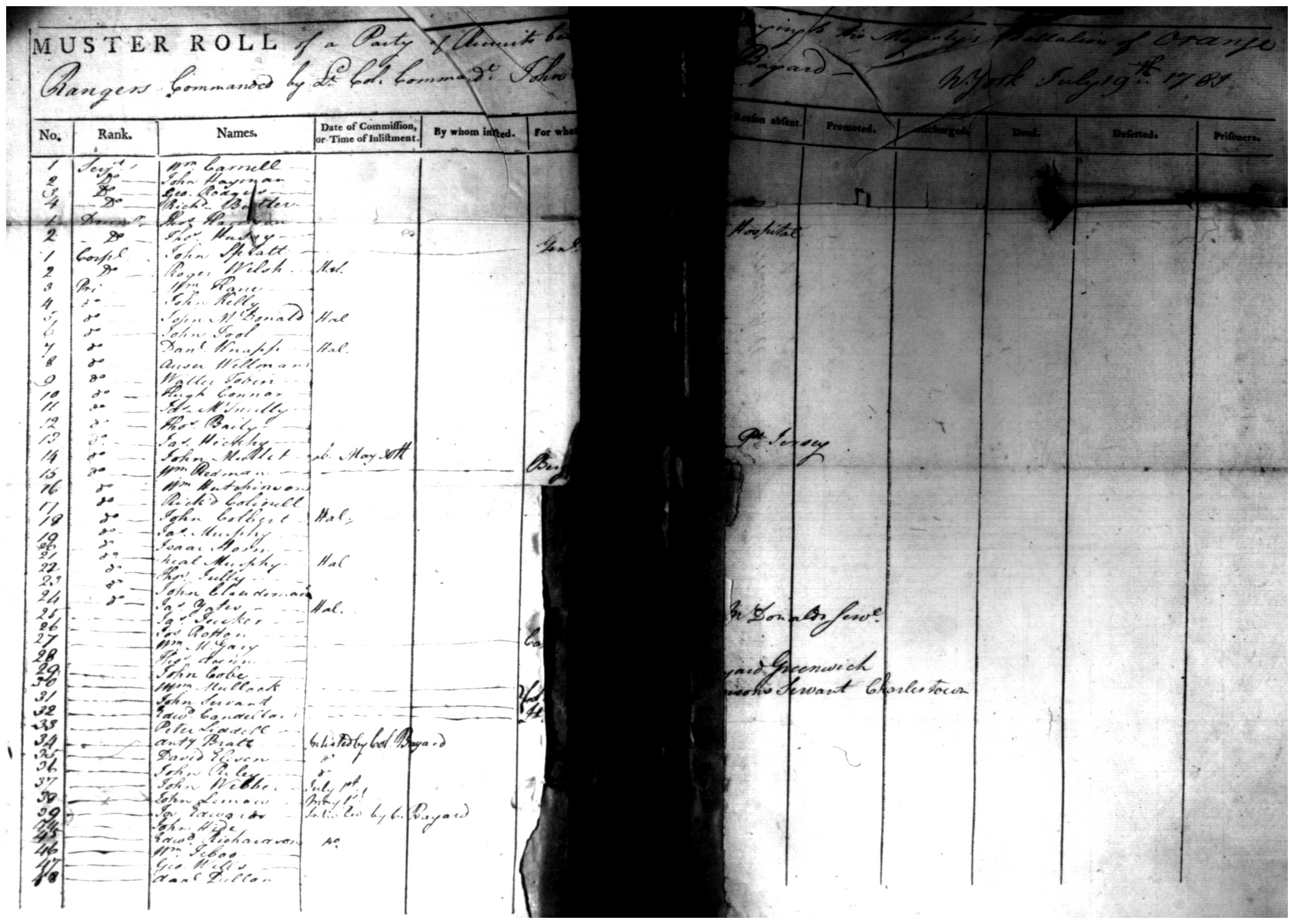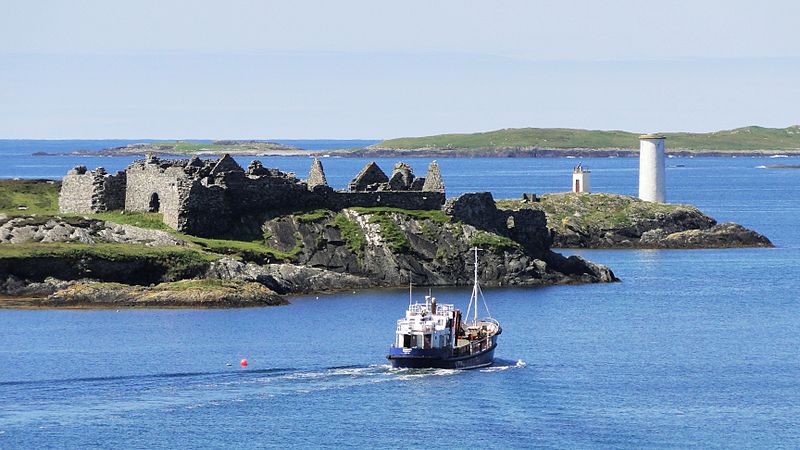- Submitted on
- 3 comments
The provincial loyalist regiment known as the King’s Orange Rangers travelled through the American Revolution, moving from New York to Nova Scotia, then scattering to many parts of the Atlantic World. Only a few individuals chose to go to the land that had been assigned to the regiment in New Brunswick at the end of the war. Two of those King’s Orange Rangers were John Howard and William Carnell and they would become embroiled in a post-war dispute which can readily be traced through land petition documents.

(Image courtesy of the King’s Orange Ranger Society)
The King’s Orange Rangers regiment was formed in late 1776 by William Bayard of New York and commanded by his son, Lieutenant Colonel John Bayard. The regiment was plagued by problems throughout its existence including an outbreak of smallpox, lack of morale and discipline, infighting between officers, and even a shipwreck. The regiment was moved from the British encampment in the Manhattan area in the fall of 1778 to Halifax, Nova Scotia; this was likely a strategic move to combat internal conflicts and desertions within the regiment. The King's Orange Rangers were to be stationed in Nova Scotia for the remainder of the war, at which time the members dispersed and were resettled.

(Library and Archives Canada, British Military and Naval Records)
Captain John Howard
John Howard joined the regiment in the spring of 1778 by way of the New York Volunteers after switching commissions with Captain John Coffin. Before the war, Howard had been a farmer with a large family in the Charlotte Precinct of Duchess County, New York; he listed his losses, which included a farm and variety of livestock, at £760 total in his claim to the British government after the war. Howard had first raised a company of the Duchess County Militia which then joined the New York Volunteers. Coffin had been having issues with the commander of the regiment, Lieut. Col. John Bayard, since Bayard had killed Lieut. William Bird (also of the King’s Orange Rangers) during a dispute and was subsequently court martialed. Howard had also had some difficulties with his military superiors in the past and many of his actions indicate that he often was involved in personal conflicts.
Howard’s Company of the King’s Orange Rangers was stationed in Liverpool, Nova Scotia in an effort to protect the local trading community against American privateers. He and other members of the unit developed close relationships with members of the town, but also instigated problems for the community such as thefts and fighting. Howard married several women from Liverpool after the drowning death of his first wife, Lucy Howard. While sailing from New York to Halifax with seven of their children in 1778, the ship went down with only one son, Edward, surviving the shipwreck. Howard’s second marriage in December 1780 was to Hannah Tinkham (widow of Dr. Perez Tinkham); third in 1782 was to Mariah West who died of smallpox subsequent to receiving an inoculation, only having been married to Howard a short while; and the fourth was to Patience Howard (her first husband being William Howard of Duchess County, New York). Howard even purchased a house in Liverpool and invested in privateering ships, becoming good friends with leading citizen, Simeon Perkins.

Sergeant/ Ensign William Carnell
Little is known about William Carnell’s life before the war, but he probably came from New York State and likely had experience as a seafarer. In a stray muster of recruits taken in New York in 1781, he was listed on the top of the document as a sergeant but he was called an ensign in other documents. It is likely he was involved in an unfortunate shipwreck suffered while on a recruiting mission with other members of the regiment toward the end of 1779. The mission was led by Captain Robert Rotton to Newfoundland, where they successfully found around fifty new members, then sailed from St. John’s, Newfoundland on December 17th for New York, but were driven off the coast by winds. The decision was made to try for Britain, and they were shipwrecked at Bophin Island off Galway, Ireland on January 27, 1780, with the ship being burned to the waterline. Carnell was probably among the surviving officers and privates who had to march south through Ireland and make their way to England and were still there in the fall of 1782.

(via Wikimedia, Drow69, CC BY-SA 3.0)
Evidence in the papers of Edward Winslow, an influential administrator of loyalist settlement in New Brunswick, included an abstract of pay from December 24, 1782 to Lieutenant-Colonel John Bayard and Ensign William Carnell of the King’s Orange Rangers, along with two private soldiers “who were in their passage to Newfoundland driven off the Coast, and Shipwrecked, and came to England, from the 25th Oct’r 1781 to the 24th December 1782.” Carnell was paid £78 for 426 days of service.
Resettlement
Howard and Carnell suffered hardships, but both eventually made their way to the land assigned to the KOR which was located east of Saint John, New Brunswick, surrounding the harbour of Quaco, now the Village of St. Martins. Carnell was one of the first settlers of Quaco, while Howard had to attend to business seeing to the estate he had left in New York and then Nova Scotia before coming to New Brunswick. The original grant at Quaco had not been specific about locations of land grants, which would cause problems in the infant community once Howard arrived and started farming by 1787; he quickly attempted to position himself to be favoured with a grant for the most useful land in Quaco.
Next Post: Two King's Orange Rangers, Part 2
Leah Grandy holds a PhD in History and works as a Microforms Assistant at the Harriet Irving Library.

Comments Add comment
Captain John Howard
Captain John Howard
Thank you very much for your comments and questions. I am not an expert on John Howard, but relied upon the work of John Leefe who has researched the King's Orange Rangers extensively. He makes the reference to Patience on page 69 of his article "History of the Royal Provincial Regiment: King's Orange Rangers, 1776-1789." Ross N. Hebb's "Quaco-St. Martins A Brief History: The First Hundred Years" also has signicant content on Howard. Howard's petition to the Commission Appointmed to Enquire into the Losses of American Loyalists (The National Archives, Audit Office 12, volume 22, p. 131-134) has some good detail on his life during the Revolution and his supporting documents in his claim were collected in Duchess County in 1786 before his arrival in New Brunswick. I hope this answers your questions and thanks again for reading.
Capt Robert Rotton
Add new comment Comments